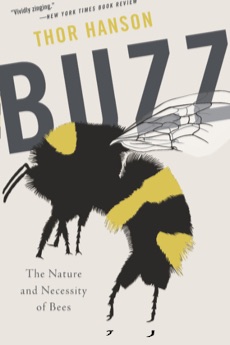Shortlisted for the 2019 ΦBK Science Award
By Jay M. Pasachoff
In this 50th-anniversary year of the Apollo 11 moon landing, we segue with “Buzz” from the second person on the Moon (or Toy Story’s Buzz Lightyear) to the onomatopoeic sound from bees. Thor Hanson is an accomplished scientist and writer, and he takes us around the world to describe many kinds of bees and their own accomplishments.
Though he describes honeybees and their importance, he makes clear that there are many other types of bees. He tells personal stories, including how his son, Noah, makes him go so slowly through the woods that they notice things that would otherwise be overlooked.
The dozens of illustrations and photos of bees and even people (Charles Darwin and French naturalist Gaston de Sporta) are, unfortunately, reproduced in murky black-and-white (and the Kindle sample download still doesn’t have them in color). He uses a drawing from a Robinson Crusoe book to make the point that though lush foliage is common in that book’s editions, the real foliage where Alexander Selkirk was stranded ashore in 1704 was drab because of the lack of bees for pollination.
Having 50,000 individuals in a single hive, as is available for view in the Smithsonian’s National Museum of Natural History in Washington, D.C., is surely impressive. The individual bees of various types that Hanson encounters are interesting too—and he stresses that for readability he calls all kinds of object “bugs.” He impresses us with statistics such as the rate exceeding 200 flaps per second—which, I guess, gave the book its name.
“Alkali” bees are one of many kinds of which I hadn’t heard, but a speed-limit photograph in an “Alkali Bee Area” in Washington State brings home their importance to the alfalfa crop.
I was impressed with bees’ navigational and memory skills, finding their way back to the hive even from great distances. And I was impressed in Hanson’s deconstruction of a McDonald’s Big Mac, to show how many of the ingredients (basically all of them aside from the beef and the bun) depend on bees’ pollination.
Of course, he discusses Colony Collapse Disorder, giving a wider range of possible contributors to the “Beepocolypse” than just the specific pesticides now usually blamed.
For me, my curiosity about the action of bees during a total solar eclipse was met by articles in Smithsonian Magazine (https://www.smithsonianmag.com/science-nature/busy-bees-take-break-during-total-solar-eclipses-180970502/), on the site entomologytoday.org (https://entomologytoday.org/2018/10/10/bees-stopped-buzzing-during-the-2017-total-solar-eclipse/) from Annals of the Entomological Society of America, and The New York Times (https://www.nytimes.com/2018/10/10/science/bees-eclipse-buzzing.html). The bees buzzed up to the moment of totality and then fell silent for totality’s duration! The schoolchildren and others can try that again in the next American total solar eclipse on April 8, 2024.
Astronomer and author Jay M. Pasachoff is the director of the Hopkins Observatory and Field Memorial Professor of Astronomy at Williams College. He is a Visitor in the Carnegie Observatories. Williams College is home to the Gamma of Massachusetts Chapter of Phi Beta Kappa.




